The Middle Ages (500 - 1500)
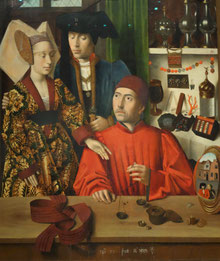
The Medieval Period, commonly called the Middle Ages, is dated roughly from 500CE to 1500CE. At
its most basic, the clothing of medieval women was floor-long or ankle-long and had likewise long sleeves. All materials were made from natural fibres, such as hemp fibres (linen),
wool, and silk. A wide variety of cloth was produced from blending these. Fur was used to trim
and line garments for warmth, while wearing fur with the hairy side out was a demonstration of magnificent rank and wealth. For the highest nobility (and among these only the ones with the
necessary cash), there was furthermore cloth of silver and gold made from silk threads wrapped with incredibly fine gold and silver wires and woven into a splendidly sparkling metallic
cloth. In much of Europe, silk needed to be imported and was thus very precious and entirely out of reach for the lower classes.
Strict sumptuary laws regulated each person's dress according to their status in society, their profession, their age and their marital status. Clothing was a very large expense in every household, in a way that is hard to imagine today. A decent comparison would be if we today spend about a quarter of our net income per year on clothing alone. Ostentatiously to prevent the middling and lower sorts from impoverishing themselves by overspending on clothing, the laws also served to distinguish the nobility from what they considered nouveau-rich upstart tradespeople.
Amidst all of this, the common denominator across all of medieval society was the wearing of
linen shifts (also called chemise, hemd or shirt) under the outer layers. Contrary to the sometimes drab, earthen tones of medieval(-inspired) shows on TV, the streets of medieval towns and
hamlets were incredibly colourful. Nearly every shade of colour could be achieved, from
pastel shades to radiant dyes. Among these, rich full dyes were more pricey than pastel clothing that was merely dipped a few times into the dye bath. Still, period sources such as the
illuminations of the manuscript Tres Riches Heures de Duc de Berry (14th century) show labourers and agrarian workers in brightly coloured frocks.
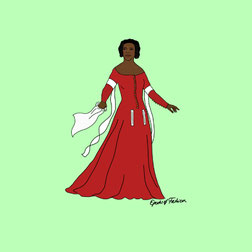
In the early Middle Ages (approximately 500 to 1000), clothing was still closely related to ancient Roman tunics. Tunics were made from two rectangular pieces joined at the shoulders with a cut-out for the neck. On each side, two rectangular pieces formed the sleeves and the side seams were then joined up down the sides. Tunics were often worn with a belt.
In the 12th century then, these tunics became more and more figure-hugging. This was achieved through darts and gathering. After 1380, the dresses could not longer be pulled over the head but had to be closed with buttons or lacing. As metal buttons were expensive, buttons made of fabric used to be worn by the less prosperous.

The cotte was worn by both women and men, a floor- or ankle-long tunic with long sleeves. The pattern was very simple as it consisted only of the front and back piece and the sleeves and sometimes of godets at both sides to offer more width. It was worn over the shift and the seams of the sleeves, the hem and the neckline were often embroidered either with stitching or braid. From the 12th century onwards the cotte became increasingly close-fitting at the waist.
A compelling source of information on early medieval dress is the tomb of Arnegunde, or Aregund. This Merovingian queen, wife of Chlotar I, died around 580 and was buried in St. Denis in Paris. Her remains remained untouched and allow, by the surviving textiles and metal ornaments, a reconstruction of her attire. Queen Arnegunde is identified by her signet ring. Over a linen shift she wore a knee-length sleeveless lilac tunic and on top a reddish-brown silken coat. The tunic is belted with a broad girdle of metal with animal ornaments. Her silk coat has long sleeves, embellished with gold braid, and reaches down to the ankles. At the neck and at waist-height it is held together by round fibulae, made of gold and inlaid with Almandine. Her stockinged feet were in soft pointed shoes made of red leather. Leather straps with silver ends around the soles of the shoes and wound cross-wise up to the calves fixed them to the foot. This fashion was new and shows the wearer to be dressed up to date. Her head was covered with a white cloth and a red stole on top, pinned together left and right to the forehead.
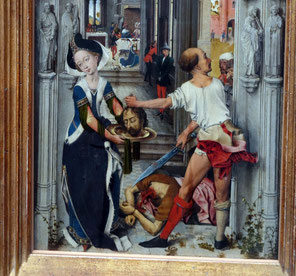
The bliaut was cut tightly until the waist where many pleats created a voluminous skirt. The sleeves likewise fell in many pleats. The neckline was close to the neck and round, with a slit in the front that was sometimes held together by a brooch. A girdle (e.g. made of bronze or golden elements) was worn to the bliaut. Noblewomen wore bliauts made of expensive textiles imported from the Orient. Sometimes the fabrics were interwoven with metal threats and embroidered. The bliaut was worn over a plain under-gown.
The surcot (also surcote) is cut in the style of the cotte, floor-long and with wrist-long, relatively tight sleeves. Moreover, it had a train. The Surcot developed into the sideless surcot, a sleeveless garment with very large sleeve holes baring the cotte beneath. As one could see the shape of the body beneath the close-fitting under-dress the Church considered this fashion immoral. Those cut-outs were usually trimmed with fur or braid and the gown was embroidered.
Terminology of historical garments is difficult as period sources often show that people back then did not have a single term in use for a specific garment. Across wills, letters and notes, a multitude of terms appear so that precise terminology sometimes remains contested.
Do you Wish to own or gift a piece of history? Check out the antique and handmade-by-me goodies in my etsy-shop:
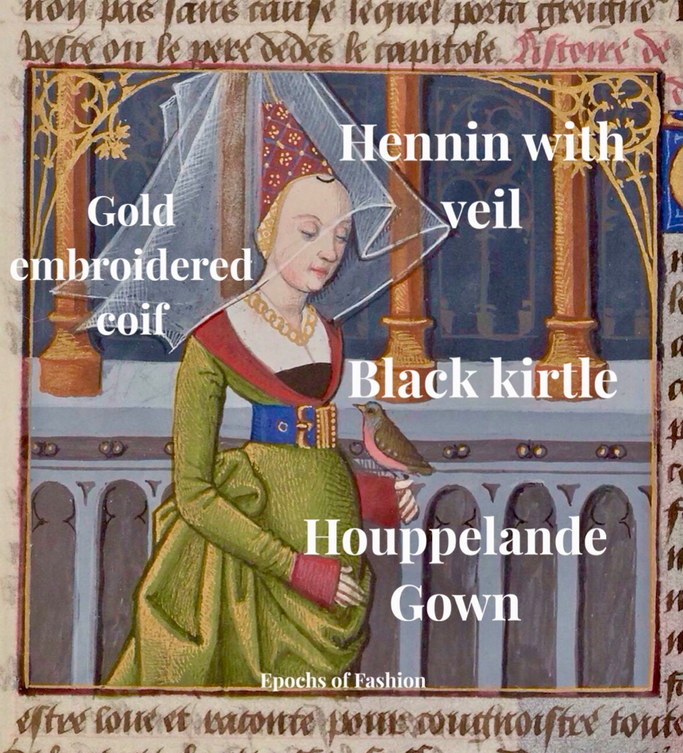
The 15th century fashion in Europe (end of the Middle-Ages, already towards Renaissance) was dominated by the prosperous Burgundian court. The whole of Europe was slowly growing more wealthy as trade between nations intensified, yet the Burgundian court outshone all others. It is now one of those great vanished kingdoms of history where a region by its name remains in France, but its immense impact on late medieval Europe cannot be guessed by that alone any more. Norman Davies' book Vanished Kingdoms is a great read for a deep dive into this subject.
The garments of this time became more voluminous (voluminous = takes a lot of fabric = prosperous wearer), often worn belted to give them shape. They were high-waisted with a full, fluent skirt and the neckline dropped. The houppelande is the chief garment of this day, worn in different lengths and cuts by both men and women in the later medieval period (14th and 15th century). The female houppelande is a very voluminous gown with long, flaring sleeves and usually belted with a decorative belt or sash. Both the hem and the sleeves could be floor-long or even longer. The commonly V-shaped neckline, the sleeves and the hem were usually trimmed lavishly with fur. Portraits often show rich, heavy velvets in strong colours or brightly patterned cloth-of-gold. The edges of the sleeves were sometimes cut into patterns like scallops, waves or leaf patterns, or adorned with ornaments such as in Jan van Eyck's painting 'The Arnolfini Marriage'.
The heuke (German) or huque (French) was a bell-shaped cloak (less material needed than a circular one) which came up in the 14th century and was an inherent part of female clothing. The heuke was, when worn by women, generally floor-long and could have a train; a hood and collar were also common.
Wedding dresses were not generally white until Queen Victoria's days in the 19th century. In medieval times, wedding clothes were not necessarily specially chosen. They could be the finest garment a person had, or made specifically as luxurious as prosperous as the family wealth made possible - and this usually meant richly coloured fabrics dyed with expensive substances and patterned or embroidered with with symbolic ornaments.
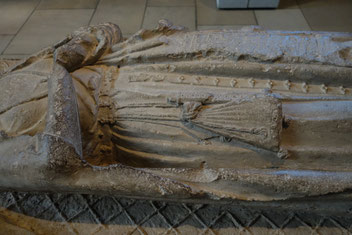
Accessories:
Brooches and clasps were important accessories. They held capes and cloaks together and offered a
space for symbolic images. Girdles could be made of leather, band/ribbon or connected metal elements. The Effigy possibly depicting a lady, possibly Margaret of Gloucester, in the MET Cloisters
collection depicts a studded belt from which a large purse hangs. This was common and other important tools were worn hanging from the belt, such as knives in sheaths, sewing tools, and sometimes
even books in special bindings. Practically every person owned their own knife. When eating, cutlery was not provided so it was the practice for everybody to get out their own knives then they
sat down for food somewhere.
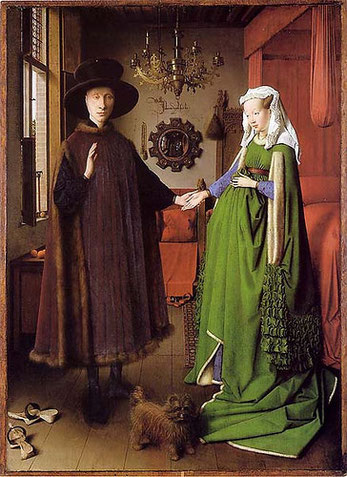
Shoes:
Leather boots were the basic footwear that almost everybody owned a pair of. Shoes were often given
to employees as part of their salaries. These leather boots could, of course, be made in many different ways - from better or less good leather, sturdier for the countryside or finer for social
occasions, or embossed with ornaments. Shoes made from wood and grasses were also made and worn for different purposes, such as agrarian work.
An iconic style of medieval footwear is the crakowes or poulaines. Said to have been
introduced from Poland (hence the name poulaines), both men and women wore this style. They were crafted of leather and the shoe tapered into a long, sharply pointed cap. At the courts, this took
on extreme lengths in a competition of aggressive fashionableness and spending money between younger aristocratic men. Note that, although footwear and a desire to own many fancy pairs of shoes
is now commonly associated in society with women, in the past this was a male area. Research into medieval cemeteries has revealed that there is a notable up-tick in bunions in medieval skeletons
during this time, caused by these tight and pointed poulaines.
Towards the end of the 15th century the poulaines were replaced by the cow-mouth-shoe, a flat
leather shoe with a very broad and short toe–caps.
Beauty:
Public bath houses shown in prints prove that the "no hygiene"-trope is fiction. There was,
however, no widespread and detailed understanding for how illnesses were transmitted and although people washed their bodies they were exposed to sickness in many areas of their lives. Medieval
people had deep knowledge of herbal and natural remedies and could therefore create effective skincare and beauty treatments. Clean, unblemished and pale skin was the beauty ideal that is
mirrored in countless medieval works of art depicting Mary, female saints and worldly women. Abbess and healer Hildegard von Bingen recommended cream made from violets to heal skin issues and
scar tissue. As violets contain salicylic acid, this was an effective anti-inflammatory treatment and violets still appear
in skincare today.

Hair:
Fair hair was European beauty ideal and hair was bleached with chamomile and by sitting in the sun (while shading
the face to preserve paleness). Uncovered, loosely flowing hair was reserved for girls and unmarried young women.
Married and older women braided their hair and covered it with linen wraps and headwear. A German proverb derived from this: "jemanden unter die Haube bringen" which means literally to "bring someone under the cap" - meaning to marry off a woman.
Headwear is a complex topic and specific styles vary not only from country to country, but often also from town to town.
A high forehead became fashionable, associated with wisdom, and plucking or shaving one's frontal hair was a common
practice of better-to-do women. Thus, no hair was visible around headdresses and the face and its fashionable pale skin is visibly enlarged.
The Gebende (German; English: “binding”) is a German medieval headpiece. It consisted of two linen ribbons: one looped from the top of the head around ears and chin and the other from the back of the head around the forehead. The Gebende can be worn with a veil, a Schapel or a medieval Pillbox-hat (often white with a crimped top or colourful and adorned).
The Schapel is a circular headdress; a circlet of metal (a plain or decorated hoop) or flowers. The flowers could either be real flowers or (metal) imitations. It came up in the 12th century and stayed fashionable until the 16th century. The Schapel was normally worn in combination with hairnets, veils or the Gebende.
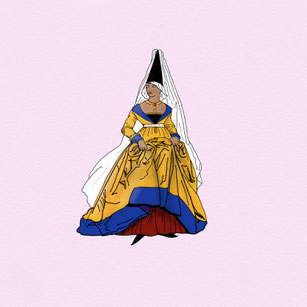
Towards the end of the 14th century, a new hairstyle established: the hennin. The new fashion spread from Burgundy all over France. This high, cone-shaped headpiece was made of a wire frame covered with fine fabric. The cone could be pointed or truncated. A long veil floated down from it. The lower edge of the hennin was framed with a cuff of monochromatic or colourful velvet or other cloth. This band could be encrusted with pearls or otherwise embroidered. A noblewomen's hennin could be as high as one metre while burgesses' wives were not allowed to wear theirs higher than a good half a metre.
The hair underneath was braided and pinned up. Then, a strip of cloth like a sweatband was wrapped around the head from the neck all the way round the forehead. This gave the hennin a place to rest on securely and also covered all hair. Then the hennin was placed on this and pinned down if necessary. Hennins also often have a little black loop in the forehead so that the wearer can adjust it and pull it back forwards if it threatens to slip off the head backwards.
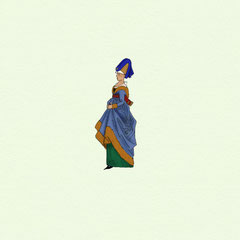
A wide variety of hennins
were worn. The double or butterfly hennin is a headpiece with two wings or cones, like two big horns. This form of the hennin existed from very high to relatively low. Over the two wings a sheer
veil (a costly, fine item in itself) was often placed.
The truncated hennin resembles later pillbox hats or Shako of Regency women.
The Piemontese hennin was wide rather than high, and can be studied in medieval manuscript illuminations from the era of writer Christine de Pizan.
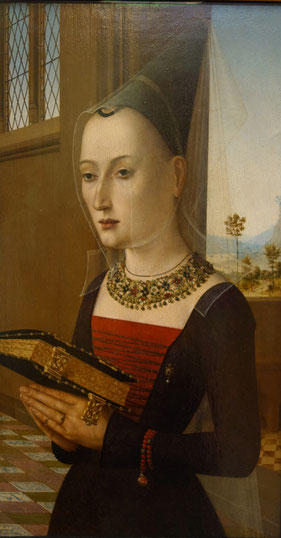
Jewellery:
Most people owned an item of jewellery, whether made very modestly or lavishly from silver or gold. Weddings were sealed with the giving of rings, like today. These were more ornamental than today's preferred simple wedding band - they could include clasped hands, hearts, a miniature representation of the couple or an allegory of love, for example. Sandra Hindman has written a lovely and informative book on this still under-researched topic, called "Golden Marvels of Byzantium: A Millennium of Finger-Rings" in which she covers third to 13th century rings.
Next to brooches, clasps and fibulae, bejewelled belts and necklaces enjoyed popularity. Maria Bonciani in the portrait to the right wears such a beautifully intricate necklace which displays both the medieval love for floral and vegetable motifs and the heights of medieval craftsmanship.
Pewter badges were popular items to adorn headwear, as belt ornaments, and collected as religious tokens on pilgrimages. These badges were cast into moulds. Some depict saints, others show animals or flowers, or are purely ornamental.
Jewellery had moreover symbolic and mythological significance. The medieval era was a time when belief in magic was widespread and co-existed alongside the major religions. The constant fear of illness and death haunted everyday life, and people took all potential remedies to ward off harm that they could. Necklaces with talismans and amulets were given in families and among friends. Symbolism, colour magic and sentimentalism were all at play. Semi-precious stones, based on the pseudoscientific concept of lapidary medicine, were considered to have good qualities. These lucky charms were believed to have magical, protective powers from harm or demons.
Earrings were somewhat rare in the northern territories of Europe until the early modern times. In the southern, Mediterranean and Byzantine influenced territories, however, they were more common.
Patterns:
Patterns for most medieval garments are relatively straight forward to construct and fit to your body. They are constructed from few pieces and are often not very fitted. Making a mock-up from some left over, old or cheap fabric can be a good way to create a pattern.
There are also patterns available commercially, such as:
- Burda 7977 (surcot laced in the back, sideless surcot)
- Burda 7468 (maid's and noblewomen's clothes)
- Butterick 4377 (dress and cape)
- Butterick 4827 (dress, underskirt, fabric belt)
- McCall's 4490 (dresses, surcot and bliaut with full bell sleeves)
- McCall's 4491 (dress with 4 different sleeve variations)
- McCall's 5499 (dresses for women and girls)
- McCall's 6376 (dresses for women and girls)
- Simplicity 2573 (dresses with headpiece and veil)
- Please note that this list claims no completeness and does not operate as advertisement. It was merely composed for informative purposes. Furthermore, no valuation of the patterns is implied or intended -
© Epochs of Fashion








